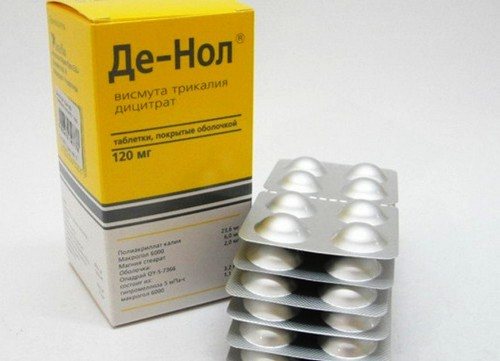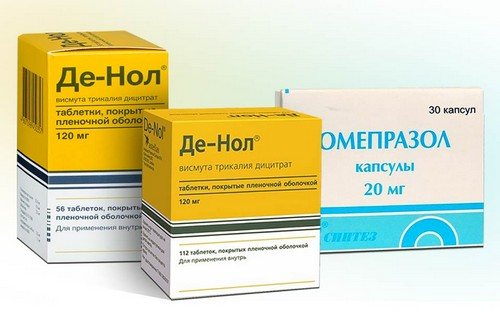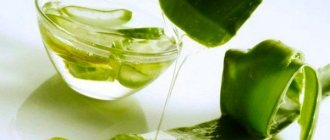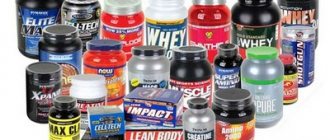Pharmacodynamics and pharmacokinetics
Bismuthate tripotassium dicitrate is characterized by a multifaceted effect, due to which the drug De-Nol affects all links in the origin and development of peptic ulcer disease .
The astringent effect is due to the ability of bismuth subcitrate to precipitate proteins through the formation of chelate complexes with them. As a result, a protective film is formed of the areas of the gastric and duodenal mucosa affected by peptic ulcer , This in turn contributes to faster scarring of the ulcers.
De-Nol exhibits bactericidal properties against the Gram (-) bacterium Helicobacter pylori . This effect is based on the ability of the active substance of the drug to suppress enzymatic activity in the microbial cell, disrupt the microstructure and permeability of its membranes, as well as the course of vital intracellular processes, reduce the mobility and virulence of microorganisms, as well as their ability to adhere. All of the above leads to the death of microorganisms.
An important feature of the drug and its difference from other drugs used to treat Helicobacter pylori is that to date not a single strain has been identified that is resistant to the action of bismuth subcitrate.
The substance dissolves very well, due to which the medicine penetrates deep into the mucus layer and inactivates microorganisms located under the mucous membrane.
Thus, the use of De-Nol tablets can reduce the likelihood of relapse of peptic ulcer .
The gastrocytoprotective effect of the drug is based on stimulation of the body's production of prostaglandin E2 ; improving microcirculation in the mucous membrane of the antrum of the stomach and duodenum; reducing the amount of hydrochloric acid; inactivation of pepsin due to the fact that this digestive enzyme forms complex compounds with bismuth subcitrate.
Bismuth subcitrate is practically not absorbed from the digestive tract after oral administration. A small amount of the substance can enter the systemic circulation, and its plasma concentration increases with prolonged use. Bismuth subcitrate is eliminated from the intestinal contents.
Treatment for Helicobacter pylori infection
This medicine is a participant in a four-component treatment regimen for gastritis and ulcers that arise due to the colonization of the inner lining of the stomach by H. pylori
Together with antibacterial drugs, bismuth salts form colloidal particles that bind to Helicobacter. Concentrations of bismuth in the layer of gastric mucus are detrimental to many bacteria after just one dose of the drug.
It is believed that the drug inhibits the enzyme systems of H. pylori, causing the destruction of their cell membrane, which leads to death. The drug helps to disrupt the attachment of pathogenic bacteria to the epithelial lining of the inner wall of the stomach.
Indications for use of De-Nol
Indications for the use of De-Nol are erosive and ulcerative lesions of the gastric and duodenal mucosa .
In particular, the drug is prescribed for gastropathy , which is a consequence of taking NSAIDs or alcohol; for gastroduodenitis and gastritis (including if the diseases are chronic or associated with Helicobacter pylori); with aggravated gastric and duodenal ulcers (including if the disease is associated with Helicobacter pylori); for IBS ( irritable bowel syndrome ), as well as for functional dyspepsia , which is not associated with organic lesions of the gastrointestinal tract.
In some cases, it is considered advisable to use De-Nol for pancreatitis (especially for biliary-dependent pancreatitis). The drug is prescribed in complex therapy to eliminate gastroduodenostasis (hypomotor intestinal dyskinesia), which is often observed in the chronic form of the disease.
Is it possible to take de Nol for gastritis with low acidity?
De Nol for gastritis is a drug with which you can quickly get rid of this disease. Since gastritis is considered the most common pathology affecting the digestive system, these tablets, having multifaceted properties, have an anti-inflammatory and enveloping effect, and also help destroy the Helicobacter pylori bacterium.
Once in the stomach, De Nol forms a protective film on its mucous membrane, promoting faster healing of damage. Thanks to this property, the drug is used as an effective remedy in the treatment of gastritis, gastric and duodenal ulcers. In addition to these diseases, De Nol has shown high efficiency and good results in the treatment of other pathological changes in the condition of the stomach and intestines. The main indications for the use of De Nol are the following conditions:
- Stomach ulcer;
- Duodenal ulcer;
- Dyspeptic syndrome;
- Irritable bowel syndrome;
- Chronic form of B-type gastritis;
- Ellison-Zollinger syndrome.
In the treatment of any of the listed diseases, the drug De Nol has shown itself only as an effective medicine that can quickly eliminate the symptoms of the disease and alleviate the general condition of patients.
You can take the drug De Nol only as prescribed by a doctor; without his recommendations, the use of this medication is prohibited. When using, it is important to adhere to the treatment regimen and prescribed dosage. Of great importance when using De Nol tablets is the correct diet and some restrictions on the foods consumed. Fatty, salty, spicy foods and dishes containing coarse fiber are excluded from the daily menu. Food should be at a comfortable temperature, that is, not too hot or cold.
When taking the prescribed dosage, it is recommended to take the tablets before meals with plenty of water. Instructions for use
Following the instructions, De Nol tablets are used, adhering to the following rules:
- For children from 4 to 8 years old, the drug is prescribed at the rate of 8 mg per kilogram of weight. The total dose is divided into two doses.
- Children under 12 years of age are prescribed one tablet in the morning and evening.
- After 12 years of age, children are prescribed an adult dose - one tablet 3-4 times a day.
- The drug is taken 30 minutes before meals, washed down with a sufficient amount of boiled or drinking water.
- Typically, the course of treatment lasts from five to eight weeks, its duration is determined by the attending physician. If necessary, a repeat course is prescribed as a prophylaxis against a possible relapse of the disease.

After completion of treatment, patients are not recommended to use medications containing bismuth for treatment for two months.
De Nol has proven its effectiveness in the presence of various gastrointestinal pathologies; a positive effect of treatment has been noted in eliminating quite serious diseases. This drug has pronounced anti-inflammatory and protective properties, due to which it is included in treatment regimens for gastric and duodenal ulcers. With gastritis with low acidity, it is important to consider that without timely treatment, this disease can take on an atrophic form with the threat of developing malignant processes.
Complete treatment of gastritis with reduced secretion of gastric juice makes it possible to achieve long-term stable remission in the chronic nature of the disease and prevent serious complications from developing. All these requirements are fully satisfied by De Nol, the use of which can quickly improve the patient’s condition and relieve the discomfort characteristic of gastrointestinal diseases. Due to its properties, the drug has a positive effect on the condition of the digestive system:
- Promotes restoration of natural regenerative functions;
- Restores healthy microflora;
- Restores immunity against harmful bacteria;
- Eliminates the negative impact of deviations from the norm in the acidity of gastric juice;
- Having an enveloping effect, it promotes the rapid restoration of natural processes in the stomach.
De Nol is able to increase microcirculation of tissues in the mucous membrane of the stomach and intestines, thereby helping to restore normal acidity of gastric juice in the case of gastritis accompanied by low acidity.
The drug De Nol helps reduce the intensity of painful manifestations that often accompany gastritis, which has high acidity of gastric juice. Increased secretion often leads to the development of peptic ulcer disease, which occurs with all the negative symptoms inherent in this disease. In this case, the use of the drug has an effective therapeutic effect, such as:
- Restores beneficial microflora;
- Increases the ability of the defenses to resist pathogenic microorganisms;
- Forms a protective mucous layer that helps reduce the negative effects of increased secretion of gastric juice;
- Normalizes digestion processes;
- Activates microcirculation processes in tissues;
- Reduces the strength of pain symptoms;
- It has a regenerating effect on the affected areas of the mucous membrane.
Under the beneficial effects of the drug, stomach tissues increase their protective properties against the effects of bacteria, as well as against the acidic environment and enzymes involved in the breakdown of food. After providing a therapeutic effect, the active substance is completely eliminated from the body through the excretory system. De Nol can help not only in the case of gastritis with high acidity, but also in the treatment and prevention of more severe abnormalities in the condition of the stomach and intestines.
Medical experts highly appreciate the drug De Nol for its antibacterial activity against pathogenic microflora. Moreover, the effective effect of the drug is achieved not only due to its direct bactericidal effect, but rather by changing the habitat of these microorganisms, creating unfavorable conditions for them.

- De Nol does not serve as a complete substitute for Omez; each of these drugs has its own properties. When prescribing treatment, the doctor assesses the characteristics of the development of the disease in each patient and, based on the conclusions drawn, decides which drug will be used.
- The action of Omez lies in its active substance – omeprazole. Due to the fact that it reacts with the acidic environment of the stomach, the activity of enzymes that stimulate the production of hydrochloric acid is suppressed. The therapeutic effect of the drug lasts on average from 17 hours to a day, the maximum effect is achieved on the fourth day of treatment. Due to its properties, Omez inhibits the development of the Helicobacter bacteria.
- The drug De Nol is a gastroprotector containing bismuth. Reacting with the contents of the stomach, it creates a film on the surface of the damaged mucosa. Increases the process of mucus production and the resistance of the mucous membrane to the irritating effects of acids and enzymes. Has a healing effect, accelerating regeneration processes.
- Both of these drugs belong to different pharmacological groups and have different principles of action, so it is not advisable to compare them. To enhance the therapeutic effect, they can be used simultaneously.
- It should be taken into account that Omez is allowed to be used by children from 2 years of age, as well as by pregnant and lactating women. The cost of this drug is several times lower than that of De Nol.
Despite the effectiveness of the drug, it also has some contraindications. It is not recommended to use this remedy or extreme caution is required in case of renal failure, especially in its severe form. Individual intolerance to the drug or hypersensitivity to one of its components should be considered as relative contraindications. De Nol for gastritis is also contraindicated in the following situations:
- Pregnancy and lactation period;
- Exacerbations of any chronic kidney disease;
- Children under 4 years of age, and from this age up to 12 years of age, use the drug only if necessary and with caution;
- When treated with medications containing bismuth.
If these requirements are not met, the use of De Nol can cause harm and worsen the condition of patients with gastritis. The dosage of the drug and the need for its use are determined by the doctor, taking into account the general condition of the patient and his individual characteristics. Treatment should be carried out under the supervision of a specialist, monitoring the body’s ability to absorb the active substance.
De Nol is a drug with minimal potential for side effects. Most often this happens when the doctor’s recommendations are not followed and the rules of use are violated. In this case, negative reactions may occur, for example:
- The appearance of nausea and the urge to vomit;
- Bloating;
- Development of an allergic reaction;
- Diarrhea or constipation.

When taking the drug, it is necessary to take into account that the main part of its active substance after the therapeutic effect is excreted from the body along with urine. Therefore, in order to prevent overstrain of the kidneys, De Nol is not recommended for long-term use. Usually the course of treatment does not exceed two months.
During treatment, it is necessary to monitor the condition of the kidneys, since the medicine is eliminated from the body gradually, and renal failure may develop in acute or chronic form. There is also a risk of developing encelophopathy and vegetative-vascular dystonia.
If the dose of the drug used is exceeded, there is a risk of impaired renal function. If this happens when using the drug for too long or when its dose is significantly exceeded, then the medication should be stopped immediately and a thorough gastric lavage should be performed. Before the doctor arrives, you must take a sorbent, activated carbon or a laxative. In severe cases of poisoning with drugs containing bismuth, based on the patient’s condition, hemodialysis is prescribed.
After stopping the drug and taking immediate measures, the patient can be given symptomatic treatment. To do this, first of all, a laboratory test of the blood is carried out to determine the bismuth content in it. If the result is increased, the patient is prescribed complex therapy designed to eliminate the changes that have occurred.
Dear readers, your opinion is very important to us - therefore, we will be happy to review the drug about De-Nol in the comments, this will also be useful to other users of the site.

Alena: For as long as I can remember, I have always tried to get rid of excess weight, but in the end I never succeeded, and in addition to the extra pounds, I also acquired gastritis. For a long time I did not attach any importance to the appearance of discomfort after eating, and when the pain became more intense, I decided to turn to specialists. The doctor scolded me and sent me for tests and an ultrasound, as a result of which a diagnosis was made - chronic gastritis. As a treatment, De Nol and a diet were prescribed, and quite strict for the period of exacerbation. One of the medicines was De Nol, and I did not immediately feel the results from use. At first I thought that it was not helping me, and only after a month and a half did I feel relief. The pain in the stomach disappeared, digestion improved. After another examination, the doctor allowed the use of many previously prohibited foods.
Olga: the drug turned out to be effective, but I think it’s a little expensive. The course required two packages, which is expensive for a young family. You can find more affordable medications in the same direction, especially if gastritis is not advanced.
Katerina : when I began to worry about discomfort in my stomach, the doctor sent me for examination. As a result, the bacterium Helicobacter pylori was discovered, which most often causes gastric pathologies. De Nol was prescribed as a therapeutic drug, which successfully fights this microorganism. After the course of treatment, the tests were good, no traces of bacterial activity were found. But to prevent a relapse, the doctor decided to conduct an additional course of treatment.
source
All iLive content is reviewed by medical experts to ensure it is as accurate and factual as possible.
We have strict sourcing guidelines and only link to reputable sites, academic research institutions and, where possible, proven medical studies. Please note that the numbers in parentheses ([1], [2], etc.) are clickable links to such studies.
If you believe that any of our content is inaccurate, out of date, or otherwise questionable, please select it and press Ctrl + Enter.
Gastritis is perhaps the most common disease of the digestive tract. It is caused by the development of the inflammatory process, which, in turn, occurs when the specific bacterium Helicobacter pylori gets on the mucous membrane. To cure gastritis, the use of anti-inflammatory drugs alone is not enough: it is necessary to protect the internal tissues of the stomach, stabilize acidity and enzyme activity, and neutralize pathogenic bacteria. The drug De-nol for gastritis is prescribed precisely for these purposes: based on bismuth, this medication successfully regulates the supply of hydrochloric acid, has a detrimental effect on Helicobacter, and covers the gastric mucosa with a softening film to protect against damaging factors. In addition, De-nol stimulates the restoration of stomach cells, heals minor tissue defects, accelerating recovery.
[1], [2], [3], [4], [5], [6], [7], [8], [9], [10], [11], [12], [13], [14]
De-nol is included in the treatment regimen not only for gastritis, but also for other pathologies of the digestive system:
- peptic ulcer (stomach and duodenum);
- chronic gastroduodenitis in the acute period;
- irritable bowel syndrome with frequent loose stools;
- functional dyspepsia, which has no connection with organ pathologies of the digestive system.
Gastritis is the main indication for prescribing the drug De-nol.
- De-nol for erosive gastritis is used in combination with medications that suppress acid production: these can be proton pump inhibitors (Omeprazole) or H2 blockers. Complex treatment allows you to eliminate dyspepsia and stop the signs of nausea and vomiting in a short period of time. In acute stress gastritis, De-nol promotes the healing of bleeding erosions.
- De-nol for atrophic gastritis is also part of the main treatment: it is prescribed together with Metronidazole, proton pump inhibitors. Therapy is carried out during the active phase of the inflammatory atrophic process. During the lull of the disease, treatment is redirected to replenish the deficiency of digestive enzymes.
- De-nol for gastritis with high acidity helps improve the protection of the gastric mucosa, normalize enzyme activity, and neutralize the activity of Helicobacter. Additionally, dopamine antagonist drugs and prokinetic agents are prescribed. Most often, the treatment regimen for this type of gastritis includes taking the drugs Motilium (Reglan), De-nol, Festal, Maalox, as well as a special diet to normalize acidity in the stomach.
- De-nol for gastritis with low acidity is prescribed as an antibacterial and enveloping agent. The main role is played by replacement therapy: pepsidil, gastric juice, acedin-pepsin are used. To activate the function of the stomach, it is appropriate to prescribe Limontar, Etimizol, Proserin, calcium gluconate.
- De-nol for chronic gastritis is prescribed in the acute stage of the disease: this drug forms a protective layer on the mucous tissues, providing many hours of protection for the organ. In addition, De-nol has high bactericidal abilities against Helicobacter pylori, so treatment takes place in several directions at once: the bacterial cause of gastritis is eliminated, stomach tissue is protected and restored. De-nol for exacerbation of gastritis is taken for 1-2 months, and bismuth preparations play a particularly important role at this stage. Chronic gastritis can be cured if you are patient and follow all the doctor's instructions exactly.
- De-nol for reflux gastritis is not used as the main drug, but only as an addition to the main treatment. The basic treatment is proton pump inhibitors (Pantoprazole, Omeprazole). It will also be necessary to improve the functioning of the hepatobiliary system (Ursohol, Urosan, etc. are prescribed for this).
- De-nol for superficial gastritis (or catarrhal) is mainly used to destroy Helicobacter pylori. Additionally, medications are prescribed to normalize acidity in the stomach, general strengthening and, if necessary, enzyme preparations.
- De-nol for hyperplastic gastritis may be useful if pathogens - Helicobacter pylori - were discovered during diagnosis. The treatment regimen is determined according to the presence of these bacteria. In case of extensive growths, surgical treatment may be prescribed, in preparation for which De-nol is also prescribed.
[15]
The basic ingredient De-nol, which is used for gastritis, is represented by tripotassium bismuth dicitrate. One tablet contains 304.6 mg of this ingredient: its properties form the basis for the therapeutic effect of the drug. By the way, here is a list of these properties:
- enveloping;
- anti-inflammatory;
- astringent;
- restorative;
- antibacterial against Helicobacter pylori.
De-nol looks like ordinary white tablets, convex on both sides, with a barely noticeable beige tint. On one side of each tablet there is embossing gbr 152. On the opposite side there is a square with rounded corners.
The tablets are sealed in blister plates, eight pieces in each blister. A cardboard package can contain seven or fourteen plates.
As we have already said, De-nol is represented by the active ingredient tripotassium bismuth dicitrate (bismuth subcitrate). This drug with a similar composition is not the only one of its kind: there are quite a lot of similar products that have the same composition, but are produced by other pharmaceutical companies. For example, De-nol for gastritis can be replaced with drugs such as Vis-Nol, Gastro-Norm, Ulcavis, Ventrisol, Escape, Novobismol, etc.
One gelatin capsule of Vis-Nol contains 499.8 mg of colloidal bismuth subcitrate (converted to Bi2O2 120 mg).
One tablet contains 320 mg of bismuth subcitrate, as well as a number of complementary substances.
The tablet contains 120 mg of bismuth oxide in the form of tripotassium dicitrate.
One tablet contains 0.12 g of bismuth tripotassium dicitrate.
One tablet contains 300 mg of bismuth tripotassium dicitrate (converted to bismuth oxide - 120 mg).
The tablet contains 304.6 mg of bismuth tripotassium dicitrate (converted to bismuth oxide - 120 mg).
The medications listed in the table are complete analogues of De-nol, which can easily replace this drug for gastritis. Preparations with a similar effect, but with a different active ingredient in the composition, are presented in the following table:
Pariet is represented by the active ingredient rabeprazole sodium.
Ampilop contains extract of Ampilopsis cantoniensis and is an antiulcer agent. Approved for use from 12 years of age. The standard dosage for gastritis is 2 capsules three times a day after meals.
A drug based on sucralfate is used in treatment regimens for gastritis, peptic ulcers, and gastroesophagitis. Venter take one tablet 4 times a day between meals.
A complete analogue of Omeprazole, used for the treatment of erosive and atrophic gastritis, peptic ulcers and reflux esophagitis. Can be used in children from one year of age.
For adults, the standard dosage is 20 mg of the drug daily, at a time. The average treatment period is two weeks.
Domestic drug, proton pump inhibitor. A complete analogue of the drug Omez.
Pantoprazole tablets (20 mg per tablet). Refers to proton pump inhibitors. It is taken by analogy with Omeprazole.
What is preferable for gastritis - Omez or De-nol - the doctor decides. In fact, these two drugs belong to different drug groups and cannot replace each other. Sometimes they are included in one treatment regimen, complementing the main antibacterial and anti-inflammatory effect. This integrated approach allows you to accelerate the restoration of mucous tissues, and at the same time the functional ability of the stomach.
Omeprazole or De-nol for gastritis are always prescribed in combination with other medications, since they have the same properties, but different mechanisms of action. And if Omez and Omeprazole are almost identical drugs, then De-nol is a completely different drug. Therefore, you should not try to replace them in a medical prescription yourself.
De-nol is a representative of the group of antiulcer drugs with bactericidal properties (meaning a bactericidal effect aimed at Helicobacter pylori). In addition, De-nol for gastritis helps relieve the inflammatory reaction and creates enveloping protection for the gastric mucosa.
The acidic gastric environment causes sedimentation of insoluble bismuth oxychloride and citrate, with the formation of chelate compounds with the protein source material, which form a protective film on the damaged surface of mucous tissues.
Along with increasing the production of prostaglandin E, De-nol stimulates mucus formation and bicarbonate secretion, activates cytoprotective reactions, strengthens the mucous membrane, making it less vulnerable to the influence of pepsin, enzyme and salt components of bile acids, and hydrochloric acid.
De-nol enhances the accumulation of a restorative agent, which is epidermal growth factor, in the area of damage. During treatment with the drug, the effect of pepsin and pepsinogen becomes less active.
[16], [17], [18], [19], [20]
The active composition of De-nol, represented by bismuth subcitrate, can be absorbed in the digestive system only in negligible quantities. Such amounts are not considered clinically significant, so the kinetic properties of the drug have not been studied in detail. It is known that less than 1% of the active ingredient is absorbed in the cavity of the stomach and small intestine, and the rest is excreted through the intestines. Such properties of the drug make it possible to take it for a long time, while the concentration of bismuth in plasma is maintained at 37.67 ± 25.06 mcg/liter and is completely eliminated on the 30th day after therapy.
The active ingredient is excreted primarily through feces. That negligible fraction of the drug that enters the systemic circulation is eliminated from the bloodstream through the renal filtration system.
[21], [22], [23]
If gastritis makes itself felt during pregnancy, then it is necessary to consult a doctor at the first sign, who will conduct a diagnosis and try to solve the problem using the safest medications.
Self-medication is unacceptable: bismuth preparations, which are used for heartburn and gastritis, are contraindicated for use by pregnant women, as they can negatively affect the nervous system of the unborn baby.
To avoid adverse consequences, before taking De-nol for gastritis, you should first discuss treatment options with your doctor. If De-nol can be replaced by any other, safer means, then it is better to make this replacement and not jeopardize the further development of the fetus.
A contraindication to the treatment of gastritis with De-nol, in addition to pregnancy, is also the entire period of breastfeeding.
The doctor will not prescribe De-nol for gastritis if the patient has certain contraindications:
- hypersensitivity of the body to bismuth-containing drugs;
- severe kidney and/or liver damage;
- the entire period of bearing and breastfeeding the baby.
De-nol is not used for the treatment of gastritis in children under four years of age.
In all remaining cases, the drug can be taken after consultation with your doctor.
[24], [25], [26], [27], [28]
It should be remembered that, despite the predominantly positive properties of De-nol for gastritis, this drug still belongs to the salts of heavy metals. Therefore, De-nol is dangerous due to the appearance of many side symptoms. Thus, during the treatment of gastritis, dyspeptic reactions may develop in the form of nausea, vomiting, loss of appetite, a “metallic” taste in the mouth, bloating, and constipation. No less often, pain appears in the area of the projection of the stomach or in the abdomen. In addition, other painful conditions may occur: gingivitis, joint pain, pseudomembranous colitis.
On the immune side, the development of allergic reactions is often noted.
[29], [30], [31]
The prescription of De-nol for gastritis involves the following treatment regimens:
- Adult patients and children over fourteen years of age take one tablet. De-nol four times a day (including before bedtime), or two tablets twice a day, between meals.
- Children over eight years old and under fourteen years old take one tablet twice a day, between meals.
- Children from four years of age to eight years old take the drug at the rate of 8 mg per kilogram of body weight per day. The resulting amount of De-nol is divided into two doses. The daily dose for this age category should not exceed 2 tablets.
A course of De-nol for gastritis can last 1-2 months. After completion of treatment, it is prohibited to take any bismuth-containing medications for the next 2 months. You can find out specific information about how much De-nol to take for gastritis from your doctor. To discontinue the drug, diagnostic confirmation of the positive dynamics of restoration of the mucous membrane and functionality of the stomach is necessary.
What is De-nol prescribed for gastritis? The so-called quadruple therapy consists of a combination of treatment with Denol and taking tetracycline (0.5 g 4 times a day), matronidazole (0.5 g three times a day) and omeprazole or another PPI (at the usual dose twice a day). This course usually lasts up to two weeks.
Before taking De-nol for gastritis, you need to make sure that female patients are not pregnant. It is also important to drink sufficient amounts of fluid throughout the entire period of therapy.
[32], [33], [34], [35], [36]
De-nol for gastritis in pediatrics can be used according to special regimens, with precise dosage calculations. Experts indicate that prescribing the drug in certain dosages and for a short course is absolutely safe for the child’s body. However, there is a limitation: the child must be over 4 years old.
In many European countries, given the increasing resistance of Helicobacter pylori to drugs such as Metronidazole and Clarithromycin, treatment with bismuth preparations is becoming more common. Some experts not only report the effectiveness of using De-nol for gastritis, but also recommend its use as a “first-line” drug. Treatment is supplemented with means to normalize the intestinal biocenosis - for example, prebiotics or probiotics.
With an increase in the concentration of bismuth in the plasma, symptoms of bismuth encephalopathy may appear:
- headache;
- dizziness;
- hyperexcitability, or vice versa, apathy;
- sleep disorders;
- photophobia;
- depressive states.
Similar complications occur when the bismuth content in the bloodstream increases to more than 1500 mcg/liter.
To avoid overdose, it is not recommended to take De-nol for gastritis for more than 6-8 weeks in a row (provided you take an adequate dose of the drug).
If signs of overdose are detected, the victim's stomach is washed, activated charcoal and osmotic laxatives are given. With persistent deterioration of kidney function, hemodialysis is indicated.
[37], [38]
Like any other medication used for gastritis, De-nol has a number of drug interactions that must be taken into account throughout the entire period of treatment. Thirty minutes before taking De-nol, as well as for half an hour after taking it, you should not take any other medications, any food or drinks.
De-nol can reduce the absorption of tetracyclines and other antibiotics.
The combined use of De-nol with other bismuth-containing drugs (we are talking about Vikalin, Vikair, etc.) can provoke an overdose against the background of an increased concentration of bismuth in the bloodstream.
Any antacids that are often prescribed for gastritis are also taken no later than half an hour before taking De-nol, or half an hour after taking it. For example, this principle also applies to such a combination of drugs as De-nol and phosphalugel: the interval between taking these two drugs should be at least thirty minutes.
Omez and De-nol are prescribed simultaneously for gastritis if there is an erosive form of the disease. However, the word “simultaneously” does not mean that the drugs should be taken at the same time. De-nol is taken two or four times a day, and Omez – once a day. The interval between taking two medications should be at least thirty minutes.
[39], [40], [41], [42], [43], [44]
The instructions suggest storing De-nol in dry places away from direct sunlight. It is preferable that the storage location is dark and the ambient temperature does not exceed +25°.
The storage location of the medication should be protected from access by children and mentally ill people.
It is unacceptable to store the medication in the refrigerator, as this may negatively affect the healing properties of De-nol.
[45], [46], [47]
De-nol can be used to treat gastritis for 4 years (the period is calculated from the production date indicated on the package).
De-nol is often prescribed specifically for the treatment of gastritis, which is explained by the pronounced anti-inflammatory, antibacterial, and enveloping properties of the medication. The drug is produced in the form of tablets: this is convenient, since De-nol has to be taken several times a day. You can take the tablets with you and take them when needed.
About 80% of patients note that De-nol is really effective for gastritis. But only if the full course of therapy is completed. For example, if the doctor prescribed a medication for 4 weeks, and the patient felt relief within a week, then this is not a reason to stop treatment: the course must be completed and not discontinued the drug on your own. To enhance the effect, De-nol is taken separately from other medications and foods. During the entire treatment course, it is recommended to exclude alcohol, strong coffee and tea, and carbonated drinks from the diet.
Many patients warn that while taking De-nol for gastritis, darkening of the surface of the tongue may occur, and stool may acquire a dark color. Such symptoms are transient and are explained by the presence of bismuth in the drug. At the end of treatment, the condition returns to normal.
source
Side effects
Side effects of De-Nol on the part of the digestive system include nausea, vomiting, constipation or increased bowel movements. These phenomena do not pose a threat to the patient's health and are transient.
In some patients, side effects of treatment may occur in the form of hypersensitivity reactions (for example, itching or skin rashes).
Long-term use of the drug in high doses can cause the development of encephalopathy caused by the accumulation of bismuth in the central nervous system.
The principle of action of the medication
The use of De-Nol for heartburn is accompanied by the following effects:
- anti-inflammatory;
- astringent;
- antibacterial against Helicobacter pylori;
After consumption, the tablet dissolves in the stomach and is not absorbed into the bloodstream. The medicine stimulates the production of mucus, which subsequently covers damaged areas of the digestive tract.
The active ingredient - bismuth oxide - reduces the production of pepsin and prevents its negative effect on the walls of the stomach.
The drug De-Nol has been proven to help with heartburn. However, it does not have a symptomatic effect, unlike antacids. The tablets act directly on the cause of the problem.
De-Nol will make you feel better if heartburn is caused by the following problems:
- ulcer of the digestive tract;
- gastritis and gastroduodenitis;
- irritable bowel syndrome;
- functional dyspeptic disorders.
De-Nol tablets, instructions for use (Method and dosage)
The manufacturer in the instructions for use of De-Nol indicates that patients over 12 years of age should take 4 tablets per day.
There are two alternative ways to use De-Nol:
- one tablet four times a day;
- two tablets twice a day.
The tablets are taken half an hour before meals. What should I take De-Nol with? You need to drink it with a small amount of water.
How to take De-Nol for children?
In accordance with the instructions for use of De-Nol, for children over 4 years of age, the optimal dose of the drug is calculated using the formula 8 mg/day. per 1 kg of body weight. Thus, depending on the child’s weight, the daily dose can be from 1 to 2 tablets. In this case, it should be as close as possible to the calculated value (8 mg/kg/day). You can take the medicine once, or you can divide it into two doses.
Children over 8 years of age are recommended to take 1 tablet twice a day.
The duration of the course is from four to eight weeks. After completing treatment, you should avoid taking bismuth-containing medications for the next eight weeks.
Recipe in Latin for tablets: Rp.: Tab. “De-Nol” N.112 DS 2 tablets 2 times a day
Why and how to drink D-Nol for diseases associated with H. pylori?
De-Nol is characterized by the ability to accumulate in the cells of Helicobacter pylori bacteria, which leads to the destruction of their cytoplasmic membranes and the death of microorganisms.
This, as well as the property of bismuth subcitrate to dissolve well in gastric or duodenal mucus and prevent the adhesion of H. pylori to the epithelial tissue of the gastrointestinal tract, allows De-Nol to be used in a variety of schemes for the destruction of these microorganisms.
Experts are inclined to believe that the additional inclusion of the drug in eradication regimens helps to increase its effectiveness without increasing the incidence and severity of adverse reactions.
The frequent use of antibacterial drugs and the widespread use of anti-Helicobacter therapy have caused doctors to note a significant increase in the number of patients with antibiotic-resistant strains of H. pylori. Therefore, to solve the problem of eradication, treatment regimens that include backup agents are used.
The patient may often be prescribed De-Nol and omeprazole , metronidazole , clarithromycin or furazolidone .
The manufacturer has published the following schemes for the destruction of H. pylori:
- 240 mg of bismuth subcitrate (De-Nol) twice a day for 30 days + 400 mg of metronidazole and 500 mg of flemoxin solutab three times a day for a weekly course (eradication - 81%);
- 120 mg of bismuth subcitrate, 500 mg of tetracycline and 400 mg of metronidazole four times a day for a weekly course (eradication - 89%);
- 240 mg of bismuth subcitrate, 400 mg of metronidazole and 250 mg of clarithromycin twice a day for a 10-day course (eradication - 95%);
- 240 mg of bismuth subcitrate twice a day, 500 mg of flemoxin solutab , 100 mg of furazolidone four times a day for a two-week course (eradication - 86%);
- 240 mg of bismuth subcitrate, 200 mg of furazolidone and 750 mg of tetracycline twice a day for a weekly course (eradication - 85%);
- 240 mg of bismuth subcitrate, 100 mg of furazolidone and 250 mg of clarithromycin twice a day for a weekly course (eradication - 92%);
- 240 mg of bismuth subcitrate, 1000 mg of flemoxin solutab and 250 mg of clarithromycin twice a day for a weekly course (eradication - 93%);
- 120 mg of bismuth subcitrate, 250 mg of clarithromycin and 250 mg of tetracycline four times a day for a 10-day course (eradication - 72%);
- 120 mg of bismuth subcitrate and 500 mg of flemoxin solutab four times a day and 20 mg of omeprazole a two-week course (eradication - 77%);
- 120 mg of bismuth subcitrate four times a day, 500 mg of clarithromycin and 40 mg of omeprazole twice a day for a weekly course (eradication - 83%).
The problem of destroying H. pylori strains resistant to metronidazole can be solved at the lowest cost by using the drug De-Nol in combination with furazolidone .
The most effective from a clinical and economic point of view is considered to be the “ bismuth subcitrate + amoxicillin + furazolidone ” regimen.
Gastritis – treatment in St. Petersburg at a low price at the Eco-safety medical center
Gastritis is an inflammation of the gastric mucosa, leading to impaired digestion of food and accompanied by a number of symptoms. Gastritis can be acute or chronic.
In addition, gastritis is distinguished with low, normal and high acidity of the stomach. Currently, gastritis can already be called the disease of the century. It affects both adults and children.
And according to health statistics, in Russia about 50% of the population has gastritis in some form.
The development of chronic gastritis can lead to:
- repeated and prolonged eating disorders;
- frequent consumption of hot, spicy or rough foods;
- poor chewing of food, dry food;
- consumption of strong alcoholic drinks;
- long-term uncontrolled use of medications that have an irritating effect on the gastric mucosa (aspirin, butadione, prednisolone, some antibiotics);
- smoking;
- frequent stress.
General symptoms of gastritis
- feeling of heaviness, discomfort in the upper abdomen after eating;
- loss of appetite (decreased or, conversely, frequent urge to eat);
- nausea, more often in the first half of the day, up to vomiting, which brings relief;
- heartburn;
- stool disorder (constipation, diarrhea or unstable stool with alternation of one or another disorder);
- belching;
- bloating;
- unpleasant taste in the mouth, bad breath.
Symptoms may vary depending on the level of acidity in the stomach. So, with high acidity, the main complaints will be abdominal pain, heartburn, increased appetite, while with low acidity, the function of digesting food suffers and patients are more often worried about heaviness in the upper abdomen, belching, and an unpleasant taste in the mouth. But each organism is individual, so relying only on complaints when making a diagnosis is inappropriate.
Diagnosis of gastritis
To make a diagnosis and prescribe the correct treatment for gastritis, a consultation with a gastroenterologist is mandatory.
You need to prepare for a doctor’s examination in advance, remember (and even write down) what complaints are bothering you and when they appear: before or after meals, as well as under what conditions they disappear. It is important to consider information about the frequency of bowel movements per day and its nature.
The doctor will evaluate the patient’s complaints, conduct an examination and prescribe the necessary amount of laboratory and instrumental examinations to clarify the diagnosis.
To clarify the diagnosis and determine the form of gastritis, the doctor prescribes an examination:
- ultrasonography;
- esophagogastroduodenoscopy (EGDS);
- general blood analysis;
- blood chemistry
- scatological examination of stool and occult blood;
- blood test for the presence of antibodies to Helicobacter pylori (relevant for dynamic monitoring);
- stool test for Helicobacter pylori antigen (a more reliable sign of the presence of the microorganism);
- breath test to determine the urease activity of Helicobacter pylori.
Treatment
Treatment of chronic gastritis consists of four main components:
- diet;
- prescribing medications that normalize the acidity of gastric juice;
- prescribing drugs that restore the gastric mucosa;
- antibacterial therapy (if infection with Helicobacter pilori is confirmed).
Therapeutic diet for gastritis
You should not prescribe a diet for yourself; it is extremely important to first consult with your doctor and undergo all the necessary examinations! First of all, nutrition for gastritis should be regular. Do not allow too long gaps between meals. Meals should be at least 5 times a day, every 3 hours.
Portions should be small, approximately 300 grams per meal. After eating, it is recommended not to lie down or lean forward for 1 hour to avoid the backflow of food from the stomach into the esophagus, which can cause heartburn and belching.
The last meal should be 2-3 hours before bedtime and consist of easily digestible foods - permitted vegetables, fruits, low-fat dairy products.
Diet for gastritis with low acidity
To stimulate the secretion of gastric juice, with gastritis with low acidity in the first days after an exacerbation, you need to eat meat and fish broths. After some time, when the acute pain passes, you can add soups and liquid cereals to the menu.
Can be eaten:
- soups, broths and vegetable broths;
- steamed fish and meat cutlets;
- soft-boiled or hard-boiled eggs, omelettes;
- jelly, compotes;
- vegetable purees;
- cottage cheese;
- boiled chicken meat.
Low acidity of gastric juice forces you to avoid:
- tough meat;
- spices;
- sauces;
- fat milk;
- whole grain bread;
- rich pastries.
Diet for gastritis with high acidity
The first two to three weeks after an exacerbation, the menu should be very gentle. It is allowed to eat chicken broth soups with the addition of cereals and milk soups. Milk reduces acidity, so you should not give it up. Low-fat milk can be added to tea or porridge.
Allowed to enter into the menu:
- low-fat milk;
- chicken broth soups;
- milk soups (not sweet);
- steamed vegetables;
- soft-boiled eggs;
- lean meats and lean fish, steamed or boiled;
- baked goods made from unleavened dough.
It is strictly forbidden to eat:
- pancakes;
- baked goods;
- Rye bread;
- dairy products;
- fatty foods;
- sausages and sausages;
- onions, cabbage and tomatoes;
- pickles and marinades;
- fried and smoked foods.
Drug therapy is prescribed by a gastroenterologist depending on the results of the examination. It is important to take the medications prescribed by your doctor correctly.
- Antacids are medications that protect the gastric mucosa from the action of irritants, primarily hydrochloric acid and bile.
- Absorbed antacids (soda, burnt magnesia, Andrews antacid, Rennie, Vicaine and Vicair quickly neutralize hydrochloric acid in the stomach and provide almost instant relief, but this process is accompanied by the release of large amounts of carbon dioxide. This increases belching, flatulence, reflux, so patients with gastroesophageal reflux disease (GERD), it is better not to use them.
- Non-absorbable antacids (topalcan, phosphalugel, magalfil, rutocide, gaviscon, reltser, almagel, maalox, gastracid) envelop the walls of the stomach, protecting them from the effects of irritants, promote healing of the mucous membrane, and also inhibit the activity of the bacterium Helicobacter pylori.
- Antacids are taken 1.5-2 hours after meals 3 times a day and a fourth time at night. Also note that antacids cannot be taken together with other medications; you need to take a break of 2 hours. This can be explained simply - an antacid will prevent the absorption of nutrients and vitamins from food and other drugs, which in this case will not have the desired effect.
- Enterosorbents (smecta, enterosgel, polyphepan, activated carbon) entering the stomach bind and evacuate harmful substances from the digestive tract. Thus, enterosorbents neutralize most of the toxins and thereby reduce their negative impact on the gastrointestinal mucosa. The sorbent should be taken 1.5-2 hours before the start of a meal or 2 hours later. Combination with other medications is not recommended.
- Gastroprotectors (misoprostol, Venter, sucralfate, enprostil, De-Nol, Cytotec, attapulgit) increase the resistance of the mucous membrane of the stomach and duodenum to the action of aggressive factors of gastric juice. These medications must be taken several times a day as recommended by your doctor, usually 30 minutes before meals or during meals and at night.
- Antispasmodics (no-spa, drotaverine, papaverine) help relieve pain and can be prescribed in both tablets and injections. They are recommended to be taken together with gastroprotectors in strict accordance with medical prescription, because they have a number of restrictions on their use. Currently, preference is given to antispasmodics that selectively affect the smooth muscles of the gastrointestinal tract (mebeverine hydrochloride - duspatalin, Niaspam, Sparex) or m-cholinergic receptor blockers with a similar effect on smooth muscles (buscopan).
- Prokinetics (cerucal, motilium, metoclopramide, ganaton) affect gastric motility and accordingly accelerate the removal of food from it. They relieve common symptoms of gastritis such as nausea and vomiting. The tablets are taken 30 minutes before meals with a small amount of water. It is prohibited to take them simultaneously with alcohol.
- Proton pump blockers or antisecretory drugs (omeprazole, pantoprazole, rabeprazole, esomeprazole, lansoprazole) reduce the production of hydrochloric acid. When prescribing these drugs, the doctor selects the drug and its dose using 24-hour pH monitoring - measuring the acidity in the upper parts of the patient's stomach. And in the future, it adjusts the treatment depending on the reaction to the action of the medicine. Therefore, when using proton pump inhibitors, individual selection of drugs is practiced.
Source: https://ecosafety.ru/ru/pacientam/vrachi/gastroenterolog/gastrit/
Overdose
A symptom of an overdose of De-Nol is a violation of the functional activity of the kidneys. The phenomenon is reversible, kidney function is completely restored after discontinuation of the drug.
Treatment of overdose involves performing a gastric lavage procedure, prescribing saline laxatives and enterosorbents. Further therapy is symptomatic.
If renal dysfunction is accompanied by a sharp increase in plasma bismuth concentration, the patient is administered chelating agents (for example, unithiol or D-penicillamine ). If renal function is severely impaired, hemodialysis .
Therapeutic regimens
Taking De-Nol is recommended for patients diagnosed with ulceration or erosion of the mucous membrane of one or more organs of the digestive system. This condition occurs with the following diseases:
- gastritis occurring against the background of increased production of hydrochloric acid;
- stomach and duodenal ulcers;
- inflammation of the duodenal mucosa and pyloric zone of the stomach;
- dyspeptic disorders of various etiologies;
- intestinal dyskinesia accompanied by diarrhea.
The effectiveness of the drug in preventing relapses in the chronic course of the pathological process has been proven. De-Nol is not used for single-component therapy, but only in complex treatment.
How to take a drug with proton pump inhibitors
Despite De-Nol's ability to reduce the acidity of gastric juice, in some cases the use of drugs with a stronger effect is required. These include proton pump inhibitors:
- Omeprazole and its analogues Omez, Ultop;
- Pantoprazole;
- Rabeprazole.
These drugs reduce the production of hydrochloric acid by glandular cells. When combining Omeprazole with De-Nol, the antisecretory activity of the drugs is enhanced, and the regeneration of damaged tissue is significantly accelerated. Gastroenterologists often include antibacterial drugs in this therapeutic regimen. How often you can take De-Nol with antibiotics to prevent relapses, the doctor conducting the treatment will tell you after assessing the frequency of exacerbations and the severity of their symptoms.
special instructions
The annotation states that the maximum duration of the course of using De-Nol is 8 weeks.
During treatment, you should not exceed the dose of the drug prescribed by your doctor and do not take other bismuth-containing drugs.
After completion of treatment with De-Nol, the plasma concentration of bismuth subcitrate ranges from 3 to 58 mcg/l. Symptoms of intoxication appear only in cases where the concentration of the substance exceeds 100 μg/l.
During the period of use of the drug, black stools are possible. The reason for this phenomenon is the formation of Bi2S3 (bismuth sulfide). Sometimes the tongue may darken slightly.
There is no data on the effect of De-Nol on the ability to operate machinery and drive a car.
Sometimes you can find the names De-Nol and Di-Nol, however, it is still correct to write De-Nol.
De-Nol - an antibiotic or not?
Despite its antimicrobial properties, De-Nol does not belong to the group of antibiotics and, therefore, is devoid of their inherent side effects.
For specialists, the drug is interesting primarily because H. pylori does not have even the slightest possibility of developing resistance to it. The inclusion of De-Nol in the regimen of combined anti-Helicobacter therapy can significantly increase its effectiveness and, in most cases, completely get rid of the infection.
In addition, the drug enhances the protection of the gastric mucosa from the damaging effects of the digestive juice contained in it and promotes its restoration. These effects develop due to the fact that De-Nol turns into a colloidal solution in the stomach.
The solution particles form a protective film on damaged and inflamed areas of the mucous membrane, which accelerates tissue healing and prevents the formation of a rough scar. The latter is very important for preventing exacerbations of the disease.
Side effects and contraindications
As mentioned above, despite the fact that De Nol is a very good anti-ulcer drug, it does have certain contraindications. So, taking De Nol is strictly prohibited if:
- There is intolerance to some components of the drug
- Kidney diseases
- Pregnancy and lactation
If we talk about side effects, the main and most common ones will be:
- An allergic reaction that results in skin rash and itching
- Nausea and bowel dysfunction
De Nol is one of the best drugs for the treatment of peptic ulcers and gastritis. Thanks to its bactericidal effect, it is able to act on such an unpleasant bacterium as Helicobater, which causes all of the above ailments. The main thing to remember is that you should never self-medicate. You should take the drug only after a doctor’s prescription and in strictly prescribed doses!
The presentation of the drug for the treatment of the stomach De Nol can be seen in the video:
Noticed a mistake? Select it and press Ctrl+Enter to let us know.
Analogues of De-Nol
Level 4 ATC code matches:
Ventrisol
Novobismol
Flax seeds
Vis-Nol
Gastrocepin
Dalargin
Venter
Vikair
Omez D
Gastrofarm
Gaviscon
Vikalin
What can replace De-Nol? Synonyms for the drug are Vitridinol and Novobismol .
Imported analogues of the drug are cheaper than its cost: Gastrofarm (Biofet, Bulgaria), Gaviscon (Reckitt Benckiser France SA), Omez D (Dr. Reddy's lab, India).
Domestic analogues: Venter (OJSC "KhFK "Akrikhin"), Vikair (OJSC "Pharmstandard-Tomskkhimpharm"), Vikalin (Irbitsky Chemical Plant), Flax seeds medicinal raw materials (CJSC "Evalar", LLC "Faros-21").
The price of De-Nol analogues is from 20 Russian rubles.
Reviews about De-Nol
Reviews about De-Nol on the forums are mostly positive. Many patients call the drug a salvation from diseases caused by H. pylori. At the same time, the medicine effectively eliminates not only the symptoms (a feeling of fullness in the stomach after eating, gastralgia, loss of appetite, belching and diarrhea), but also the cause of the disease.
De-Nol suppresses the activity of pathogenic flora, restores the protective properties of the stomach and reduces the likelihood of relapse.
Doctors in reviews of De-Nol note that the best results can be achieved if the product is used as part of complex therapy. Quadruple regimens showed the greatest effectiveness, in which, along with bismuth subcitrate tablets, Omeprazole , Trichopolum and the antibiotic Clarithromycin or Amoxicillin .
It is also considered equally important to include immunomodulators . This is due to the fact that patients with Helicobacter pylori infection (especially children) often experience immune dysfunction .
Studies have found that the use of cycloferon (an interferon ) in pediatric practice in patients with HP infection can increase the effectiveness of therapy from 73 to 93%.
Preparations for complex treatment of esophagitis with De-Nol
The initial stage of esophagitis is eliminated with the help of diet therapy. In other cases, patients are recommended to take:
- De-Nola for esophagitis,
- antisecretory drugs,
- proton pump inhibitors (Omeprazole, Pantoprazole, Lansoprazole),
- prokinetics (Motelac, Motilium, Cerucal). The medicine will speed up the movement of food through the gastrointestinal tract and speed up intestinal evacuation. Selective drugs of the new generation act more gently and safely,
- antacids (Maalox, Gastal, Almagel) - means of symptomatic relief that act for a short time. With prolonged use, they provoke reverse emissions, deterioration of well-being, and increased gas formation.
Proton pump inhibitors (PPIs) are the basic treatment for esophagitis. Such medications normalize acidity levels and maintain therapeutic effectiveness from 30 days to 12 months after completion of the course of treatment. The selection of a suitable active substance and dosage is carried out after obtaining the results of pH measurements.
The dosage of medications and the course of therapy depend on the degree of development of the inflammatory process, the clinical picture, concomitant diseases, and the individual characteristics of the patient’s body. An interval is maintained between taking bismuth and other medications. Patients with gastrointestinal problems should be under constant medical supervision.
De-Nola price, where to buy
How much does the medicine cost in Russian pharmacies?
The drug is produced by only one company, so the price of De-Nol in St. Petersburg, Omsk or Moscow differs slightly.
On average, the price of 56 tablets of De-Nol 120 mg varies from 450 to 510 rubles. The cost of package No. 112 is about 900 rubles.
You can buy D-Nol in Moscow and other Russian cities both in a regular pharmacy and online.
Cost of De-Nol in Ukraine
The price of De-Nol in Mariupol, Kharkov, Kyiv and other large cities is about 220 UAH for package No. 56 and about 390 UAH for package No. 112.
Cost of the drug in Belarus
Price of tablets 120 mg * 56 pcs. - from 150.4 to 220.5 thousand rubles, the price of 120 mg tablets * 112 pieces - from 266.5 to 376.2 thousand rubles.
The dosage of the active substance in tablets is 120 mg. It is pointless to look for a medicine with a higher concentration of bismuth subcitrate (for example, 240 mg).
- Online pharmacies in RussiaRussia
- Online pharmacies in UkraineUkraine
- Online pharmacies in KazakhstanKazakhstan
ZdravCity
- De-Nol tablets p.p.o.
120 mg 32 pcs. JSC R-Pharm/ZAO Ortat RU / ZIO Zdorovye 312 rub. order - De-Nol tablets p.p.o. 120 mg 112 pcs. ZiO-Zdorovye ZAO
RUR 759 order
Pharmacy Dialogue
- De-Nol (tab.p.pl/vol. 120 mg No. 56) R-Pharm CJSC
RUB 482 order
- De-Nol (tab.p.pl/vol. 120 mg No. 56) R-Pharm/Ortat
RUB 496 order
- De-Nol (tab.pl/vol. 120 mg No. 56)Astellas Pharma
RUB 503 order
- De-Nol (tab.p.pl/vol. 120 mg No. 32) R-Pharm/Ortat
RUB 334 order
- De-Nol (tab.p.pl/vol. 120 mg No. 112) R-Pharm/Ortat
916 RUR order
show more
Pharmacy24
- De-nol 120 mg No. 112 tablets Astellas Pharma Europe B.V., Netherlands
393 UAH.order - De-nol 120 mg No. 56 tablets Astellas Pharma Europe B.V., Netherlands
216 UAH order
PaniPharmacy
- De-nol tablets De-nol tablets 120 mg No. 56 Netherlands, Astellas Pharma Europe
254 UAH order
show more
Characteristics of the drug
De-Nol in tablets 120 mg refers to bismuth preparations for the treatment of diseases of the gastrointestinal tract or stomach.
It promotes the healing of ulcers, relieves inflammation of the mucous membrane, and coagulates the Helicobacter pylori protein. The use of the drug is indicated in the treatment of:
- exacerbation of gastritis, ulcers, other inflammatory, erosive diseases of the gastrointestinal tract with a high level of acidity;
- dyspepsia;
- relapse of peptic ulcers, gastroduodenitis, other inflammatory, erosive pathologies of the gastrointestinal tract with impaired gastric secretion;
- functional bowel disorder;
- for eradication of Helicobacter infection.
The therapeutic effect of De-Nol lies in its enveloping effect: the tablets react with the components of gastric juice and form a foamy substance. It covers the damaged mucous membrane with a dense layer from the inside.
Foam film formed:
- prevents irritation of the membrane by enzymes, bile, hydrochloric acid, food and/or vital activity of Helicobacter pylori;
- activates the production of PGE2, thereby improving the quality of intragastric mucus and increasing its quantity;
- prevents the movement of microbes to the stomach wall.
This gastroprotector also reduces the negative effect of pepsin on the mucous membranes in people with high acidity.










